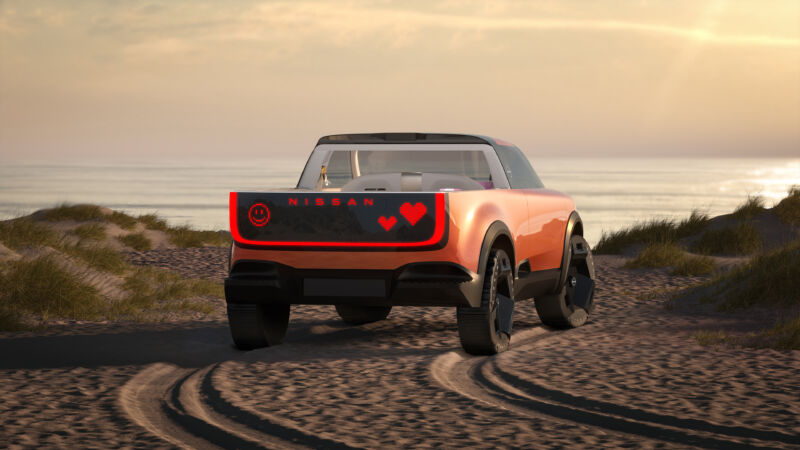
As more and more automakers have turned their attention to electric vehicles, one-time leader Nissan finds itself playing a game of catch-up. In an attempt to make up for lost time, the company announced on Monday that it will invest $17.6 billion over the next five years “to accelerate the electrification of its vehicle lineup and rate of technology innovation.”
The plan, called “Nissan Ambition 2030,” is notable for its lack of ambition.
The company says it will introduce 15 new EVs, though it gave itself a generous deadline of 2030. Nissan also said that, by the end of the decade, 50 percent of Nissan and Infiniti sales will be “electrified,” which is industry-speak for adding electric motors, not necessarily supplanting internal combustion engines. Much of Nissan’s strategy relies on series hybrids, where a range-extending gas engine will recharge a small battery. It’s a strategy that looks good on paper but has largely been abandoned by other automakers either because of mediocre sales (Chevy Volt) or looming government regulations.
Nissan is also betting big on all-solid-state batteries, an encouraging but unproven technology. Solid-state batteries promise to bring down the cost and weight of EV batteries packs while also making them safer. Pretty much every major automaker has a plan to bring solid-state batteries to its lineup. Nissan says it is spending $1 billion toward developing its own solid-state chemistry, with a pilot factory planned for 2024 followed by a commercial introduction in 2028. Given the state of other companies’ solid-state efforts, those are both realistic timelines.The difference between companies that have been lagging in the EV race—like Nissan and Toyota—and those that are surging forward—like Volkswagen, Ford, and GM—is that the latter group isn't waiting for solid-state batteries to mature. All three companies have announced that they’re spending billions of dollars to bring several massive battery plants online in the next few years. GM, for example, has said it will spend $27 billion over five years on battery electric and autonomous driving tech, introducing 30 EVs by 2025.
Previous strategy
Like other Japanese automakers, Nissan has been hesitant to embrace battery electric vehicles, in part because the Japanese government has placed a significant bet on hydrogen. In 2017, the country announced its “Basic Hydrogen Strategy,” which called for fuel cell vehicles to replace gas-powered cars and trucks.
But Nissan may be doubly cautious because its early bet on EVs, the Leaf, did not reach the lofty goals set by former CEO Carlos Ghosn. In 2013, Ghosn said that Nissan and its alliance partner Renault would be selling 1.5 million annually by 2016. Months later, he backpedaled, but even his correction ended up being optimistic. Nissan and Renault’s cumulative sales for the last decade, while impressive, aren’t even close to what Ghosn had hoped to sell in one year. (Ghosn was arrested in 2018 on charges of financial misconduct and was forced out of the company.)
The sales shortfall isn’t because the Nissan Leaf is a bad car but because it remains the only EV the company has to sell. Today, the model is stuck fighting an uphill battle—it’s a compact hatchback with limited range in a market that favors crossovers that can travel more than 250 miles on a charge. Nissan will address the Leaf’s shortcomings with the Ariya crossover, set to launch next year. But when the Ariya finally arrives, it will be a late entrant to an increasingly crowded field and carry a price tag that would make most current Nissan owners blush. And it will bring Nissan’s total EV offerings to... two.
Not alone
Squandering an early lead is a recurring theme in the automotive industry, especially when it comes to alternative propulsion. Toyota was among the first to sell hybrid cars, and over the last couple decades, it has come to dominate the market. But thanks in part to that success, Toyota delayed investing in EVs and, more recently, has fought governments that seek to ban new sales of gas- and diesel-powered light vehicles. BMW, on the other hand, embraced EVs in 2013 with the i3 but then didn’t introduce another fully electric model until this year.At the end of 2020, Nissan announced that it had sold a cumulative 500,000 Leafs globally in the decade that the car had been on sale. Coincidentally, one month later, Tesla announced that it had delivered 500,000 all-electric vehicles in 2020 alone. The first Tesla Model S hit the road about 18 months after the first Leaf was delivered. Why the divergent paths? Tesla had committed to its strategy while Nissan had not.
"strategy" - Google News
November 30, 2021 at 05:47AM
https://ift.tt/3d6jXkw
Nissan announces halfhearted EV strategy after fumbling its lead - Ars Technica
"strategy" - Google News
https://ift.tt/2Ys7QbK
https://ift.tt/2zRd1Yo
Bagikan Berita Ini















0 Response to "Nissan announces halfhearted EV strategy after fumbling its lead - Ars Technica"
Post a Comment